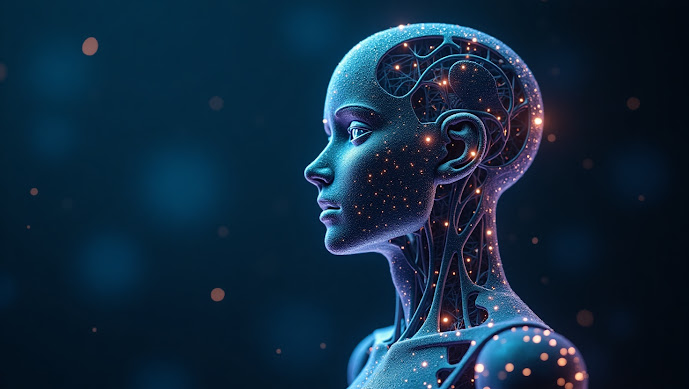Artificial Intelligence: The Future Is Here, and It’s Changing Everything
Imagine a world where your doctor catches a disease before you even feel sick, where your car drives itself while you relax, or where your personal assistant isn’t a person at all—it’s a machine that learns and adapts, almost like a friend. This isn’t a scene from a sci-fi movie; it’s happening right now, in 2025, thanks to artificial intelligence (AI). AI has quietly slipped into our lives, and it’s transforming everything—from the way we work to the way we dream about tomorrow. So, what is this incredible technology, where did it come from, and where is it taking us? Let’s dive in.
What Is AI, Really?
At its heart, AI is about teaching machines to think, learn, and make decisions in ways that feel a little human. Picture it like this: traditional software is a set of rigid instructions—like a recipe a robot chef follows to the letter. AI, though, is more like a curious cook who tastes the dish, adjusts the spices, and gets better with every meal. It uses something called machine learning, where it learns from experience by sifting through mountains of data, spotting patterns, and improving over time.
There are two flavors of AI to know about:
Narrow AI: This is what we’ve got today. It’s brilliant at specific jobs—like suggesting the perfect song on Spotify, helping your phone fix your typos, or powering facial recognition to unlock your screen. It’s focused, fast, and already everywhere.
General AI: This is the big dream—a machine that can think and reason like a human about anything, from solving math problems to writing poetry. We’re not there yet, but the idea alone sparks both excitement and wonder.
A Quick Look Back: How AI Got Here
The story of AI starts long before computers even existed. Ancient myths dreamed of talking statues, and old sci-fi tales imagined robots with minds of their own. But AI as we know it kicked off in 1956, when a handful of curious scientists met at Dartmouth College and said, “Let’s build machines that think.” The early days were rough—computers were slow, and data was scarce. AI had its highs and lows, with moments of hype fading into quiet setbacks.
Then came the 21st century, and everything exploded. With oceans of data from the internet, lightning-fast computers, and brain-inspired algorithms called neural networks, AI took off. By 2012, machines could recognize pictures better than humans. Soon after, they were outsmarting us at tricky games like Go. Now, in 2025, AI powers everything from life-saving medical tools to cars that steer themselves. It’s not just progress—it’s a revolution.
AI in Action: Where It’s Making Waves
By 2025, AI isn’t just a buzzword—it’s a game-changer. Here’s how it’s reshaping the world:
Healthcare: Imagine a doctor who never misses a clue. AI is analyzing scans, predicting diseases, and tailoring treatments to your unique body. It’s catching cancers early and saving lives in ways we once only hoped for.
Business: AI is the tireless assistant every company dreams of. It’s answering customer questions with chatbots, streamlining warehouses, and even predicting what you’ll buy next. It’s efficiency on steroids.
Transportation: Self-driving cars are rolling out, guided by AI that sees the road better than we do. Systems like Tesla’s Autopilot are cutting accidents and turning commutes into chill time.
And it’s not just the big stuff. AI’s in the little things too—your thermostat tweaking itself to your routine, your phone knowing your face. It’s subtle, seamless, and all around us.
The Flip Side: Challenges We Can’t Ignore
But AI isn’t perfect. With all its brilliance come some real hurdles:
Job Displacement: As AI handles repetitive tasks—like answering phones or sorting data—jobs are shifting. It’s not just factory workers; even creative fields feel the pinch. We’ll need new skills and new ideas to keep up.
Bias and Fairness: AI learns from the data we feed it, and if that data’s skewed, so is the AI. There’ve been cases of AI favoring certain groups in hiring or loans—not because it’s mean, but because it mirrors our flaws. Fixing this means cleaning up our data and our thinking.
Privacy: AI loves data—your data. Every click, search, and selfie fuels it. But who controls that info? With privacy rules lagging behind, it’s a question we can’t dodge.
And then there’s the big “what if”—what happens if AI gets too smart? It’s a distant worry, but one that keeps experts up at night. The trick is moving forward without losing control.
What’s Next for AI?
The future of AI is a mix of promise and possibility. Here’s what’s on the horizon:
Explainable AI: Today, some AI feels like magic—we don’t always know how it decides things. But there’s a push to crack open the black box, especially for big decisions in healthcare or money matters.
Edge AI: AI’s moving closer to you—into your phone, your car, your watch. It’ll work faster and keep your data safer by skipping the cloud.
AI for Good: Beyond profits, AI’s tackling huge problems—tracking climate change, boosting education, helping the underserved. It’s tech with a heart.
And that dream of general AI? It’s still out there, shimmering on the edge of imagination. Whether it’s decades away or never arrives, it’s a goal that keeps us pushing the boundaries.
The Bottom Line: AI Is Ours to Shape
Artificial intelligence isn’t a far-off fantasy—it’s here, rewriting how we live, work, and dream. It’s spotting diseases, driving our cars, and quietly making life smoother. But it’s not flawless. The challenges—jobs, bias, privacy—demand our attention, and the ethical questions push us to think harder about what we value.
As we step into this AI-powered world, one thing’s clear: it’s not just shaping the future—it’s handing us the pen to write it. So, what story will we tell? The choice is ours.











0 Comments